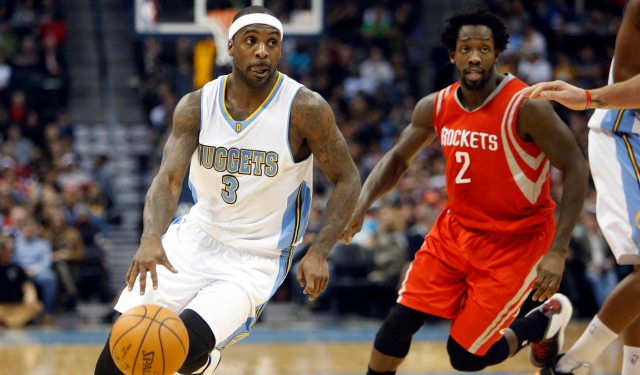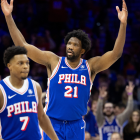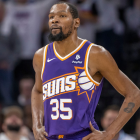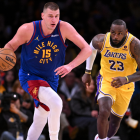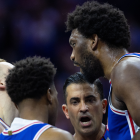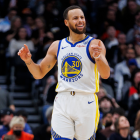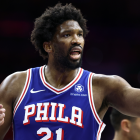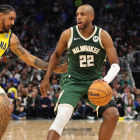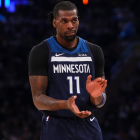When the Tracy McGrady-Yao Ming combination for the Houston Rockets spent more time on the trainer's table than the court, the Houston Rockets were forced to regroup. As the NBA started to evolve into an era of teams trying to construct a Big Three like Pat Riley and the Miami Heat did, having the superstar combination like we saw during the Shaq and Kobe era in Los Angeles changed to the superstar trio. Rockets general manager Daryl Morey knew he had to acquire assets in order to acquire the flexibility to be in position to swing deals and attract free agent targets.
After being a treadmill team in the Western Conference for a few years, the Rockets struck gold in their acquisition of James Harden right before the 2012-13 season. A year later, Morey convinced Dwight Howard to leave the Los Angeles Lakers and join up with Harden in H-Town. The Rockets chased trying to sign Chris Bosh, LaMarcus Aldridge, and Carmelo Anthony since signing Howard -- hoping to grab that third star to complete the triumvirate. With the trade of Ty Lawson from the Denver Nuggets to the Rockets, Morey has presumably found his third star.
All of this will be contingent on how quickly and well Ty Lawson's off the court problems are addressed, but if he can fix that aspect of his life, the on-court fit with Lawson and what the Rockets like to do is pretty much perfect. The three big takeaways from where the Rockets try to attack the most are in transition, from the 3-point line, and in pick-and-roll sets.
Lawson under George Karl in 2012-13 was probably his most effective season. While his stats weren't the best we've seen, his accuracy in the way he scored was top-notch and he was a constant threat with the ball in his hands. Under Brian Shaw and then Melvin Hunt, his numbers improved but his efficiency wavered a bit. In putting him next to James Harden and finding ways to help him control the offense, the Rockets could have one of the deadliest backcourts in the NBA.
This is a similar attack the Rockets tried to employ with the Jeremy Lin-James Harden combo back in 2013-14. Lin is a decent 3-point shooter, who also thrives in pick-and-roll situations. Lin did well as a spot-up shooter next to Harden and he ran pick-and-roll plays extremely well. The problem was he was a disaster in transition opportunities. Of the 41 players who had at least 200 transition scoring possessions, only rookie Michael Carter-Williams and Evan Turner had a lower points per possession than Lin.
The Rockets were actually quite good with the pairing of Lin and Harden on the floor together. They had a net rating of plus-7.6 points per 100 possessions -- higher than their 5.5 for the entire season. They put up a pretty stellar 109.9 points per 100 possessions with those two on the floor and the defense was solid. But Lin's shortcomings in transition and defensively (along with his big salary number in the final year of his contract) opened the door for Patrick Beverley to end up as the starting point guard last season.
Houston retained Beverley in free agency this summer, but potentially moving him to the bench or using Lawson as the primary point guard next to Harden for the majority of the minutes could turn the Rockets into an elite offensive team. For all of the star power, record-setting 3-point shooting, and pace pushing the Rockets did last season, they still only ranked 12th in offensive rating. That's not bad by any means, but it's also not elite. The previous season they were fourth in offense but hadn't made the leap defensively we saw in 2014-15.
Lawson struggles defensively because of his smaller stature compared to most NBA point guards. Stephen Curry infamously used him as a human ball rack during the 2013 first round. But his advantages on offense may make up for it and the Rockets will still have Beverley to employ for stretches to get key stops.
Over the past three seasons, Lawson has excelled at destroying teams in the pick-and-roll. His quickness with the dribble and ability to score from all over the court make him almost impossible to defend. There hasn't typically been much a defense can consistently do to counteract Lawson as a pick-and-roll initiator. If you go under the pick, he hurts you. If you go over the pick, he hurts you. Dribbling his man into the pick and forcing a switch usually ends up in points.
And Lawson has become so adept at keeping his dribble alive and finding cutters after the initial containment of the pick-and-roll that he really makes the defense have to extend far longer than what most point guards do to a defense. His patience along with the quickness of his moves is a tough combination to defend against.
Back in the 2012-13 season, Lawson helped direct the Nuggets to a 57-win season under George Karl and they played with the second fastest pace in the NBA (second only to the Rockets). Lawson destructed transition defenses, scoring 1.183 points per possession and shooting 62.3 percent in transition possessions. When you include assists in transition with the scoring, only LeBron James created more points per possession than Lawson for players with at least 400 possessions.
The Rockets played the second fastest pace this past season (only behind the Golden State Warriors), but they were a below average team in transition efficiency (17th overall). Houston actually scored the second most transition points in the NBA, but they had so many attempts come up empty and just had an overwhelming volume of transition chances. If they can add the efficiency of what Lawson brings in the open court with the volume they've employed since Harden joined the team, you might see the Rockets jump to being a smothering offensive entity.
Maybe the only offensive concern on the court for the Rockets and Lawson could be how he shoots from downtown. He's a career 36.9 percent 3-point shooter, which is more than adequate for the type of volume outside shooting they love to do. However, he's seen a decline in his 3-point shooting over the majority of his career. He went from being an above 40 percent 3-point shooter his first two seasons to about 36.5 percent the next two years. Then he saw it dip to 35.6 percent two seasons ago before finally dropping below league average at 34.1 percent.
That could have been just a product of Shaw's offense and style of playing not meshing with what Karl had Lawson doing causing the decline. I think you have to trust Lawson's shot and shot selection with this acquisition. The Rockets will also trust Harden and Lawson to be able to share the playmaking duties, which could make Harden even better. Harden had a 31.9 percent usage rate last season, which was by far the highest of his career.
By getting that back below 30 percent, we could see Harden have even more focus and energy to expend on the offensive end of the court, which should lead to a higher level of his already impressive high volume, high efficiency attacking. Harden playing more off-ball and not having the entire responsibility of the offense on his shoulders could lead to much more energy as the season goes on and fresher legs to be even better in the playoffs.
There are still a lot of things to figure out with Lawson and his current off-court struggles. But there shouldn't be any doubt the Rockets added a dynamic player to their roster. Morey may have finally found his Big Three.
